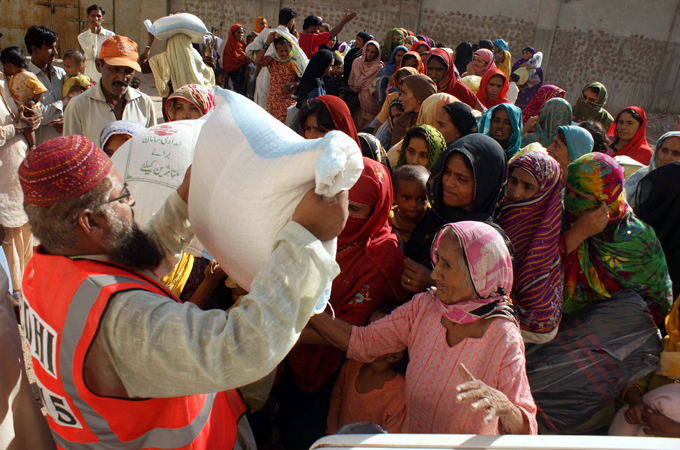Agencies say Pakistan flood aid ‘drying up’
Aid groups say their work may grind to a halt if international donors fail to meet 73 per cent shortfall in funds.

 |
| Addressing the lack of food and the threat of water-borne diseases are currently aid agencies’ top priorities [EPA] |
Vital flood relief efforts for five million people affected by floods in Pakistan’s south could be cut because of a shortfall of foreign donations, international aid groups have warned.
Less than a third, about 27 per cent, of a $357m floods appeal by the United Nations for 2011 has so far been met.
Keep reading
list of 4 itemsTurtles swimming to extinction in Malaysia as male hatchlings feel heat
Could shipping containers be the answer to Ghana’s housing crisis?
Thousands protest against over-tourism in Spain’s Canary Islands
Oxfam, Save the Children, CARE, and the umbrella group the Agency for Technical Co-operation and Development (ACTED), have all urged donors to give more or see aid work grind to a halt.
Supplies of clean water, sanitation, food, shelter and healthcare are all under severe threat, and impoverished farmers in the province of Sindh face losing most of their winter crops, with cold weather setting in.
The province was already reeling from last year’s floods, the worst in Pakistani history, when this year’s deluge hit.
‘Unimaginable catastrophe’
Neva Khan, Oxfam’s country director in Pakistan, said: “Over two months into the crisis, millions of people are still without basics. If relief operations stop, it could lead to an unimaginable catastrophe.
| IN VIDEO |
|
|
| Al Jazeera’s Inside Story examines the crisis |
“With winter approaching fast, millions of people who are still without shelter will be left out in the cold.
“We urgently need to see the same donor generosity and giving that took place last year during the floods.
“We [Oxfam] have sufficient resources to continue operations [in eight districts of Sindh] until December, but we are very concerned about the situation post-December,” she told Al Jazeera.
Khan said that her agency’s planning figure for those affected was 3.9 million people, with a cost of delivering aid of $36m.
“We’ve managed to resource just around 36 per cent of that,” she said, warning that with winter setting in, the dangers posed by water-borne diseases was particularly acute.
Save the Children has raised only about 35 per cent of its required funds, while CARE says it only has 9 per cent of the funds it needs to carry out relief work.
‘Distressingly underfunded’
The US and European Commission have given the most money to the UN appeal, donating $13.4m and $20.6m respectively.
Stacey Winston, from the UN, said the 2011 fund “remains distressingly underfunded with a 73 per cent shortfall and if more funding is not received relief supplies will run out within weeks”.
The figure of aid met includes funds pledged by foreign governments and those actually transferred to aid agencies.
According to official figures, more than 1.58 million homes in Sindh and 26,000 in neighbouring Balochistan province were damaged in the 2011 floods.
About 800,000 people are still displaced, and the latest estimates suggest that three million people remain in urgent need of emergency food supplies.
Food insecurity
Farmers in Sindh and elsewhere are in need of help to plant a new season of crops, while millions of people remain at risk of contracting diseases from stagnant water, including malaria, dengue fever and respiratory diseases.
“We had expected the situation to stabilise by now but conditions are going from bad to worse,” warned David Wright, Save the Children’s Pakistan country director.
“Malnutrition levels among children under five are among some of our worst-recorded cases.”
Khan told Al Jazeera that food insecurity had been a problem in Sindh before the floods, with 72 per cent of the province’s population classified as “food insecure”.
She said that with most of the winter’s crops wiped out, people were in desperate need of help in either replanting crops or securing their livelihoods in other ways.
Khan said that women, children, the elderly, those with disabilities and those with chronic health conditions remain at the most risk.